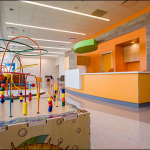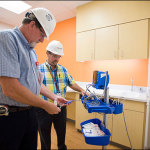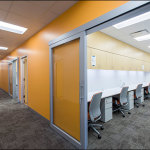 By Andrew Kragie, Houston Chronicle
By Andrew Kragie, Houston Chronicle
Pediatric surgeon Dr. David Wesson talks to the Houston Chronicle about gunshot wounds in children.
Dr. David Wesson points to a spot below his belly button. That’s where the .22-caliber bullet pierced the abdomen of the first pediatric gunshot victim he ever treated.
The boy was 1 month old. He was perched on the kitchen table. His father had been cleaning a rifle when it unexpectedly discharged. The bullet ricocheted through the infant’s body.
The surgeon’s finger traces upward across his white coat, zig-zagging like a child’s pencil following the lines of a maze: through the abdomen, into the liver and out the back.
The baby survived, Wesson said, but the Texas Children’s Hospital trauma surgeon still remembers the bullet’s path three decades later – and it still bothers him.
“When you treat somebody for cancer, you really feel that there’s not much anybody could have done to prevent that,” Wesson said. But not so with a child who’s been shot.
“You’re always thinking that, well, that could easily have been prevented,” Wesson, now a grandfather of six, said during an interview in the emergency department’s exam room.
In the last six days of July, three Houston-area children – boys 5, 7 and 11 – accidentally shot themselves in separate incidents, authorities said. Two died. Doctors and gun-safety experts say these events are doubly tragic because they are avoidable.
Houston doctor gives inside look at trauma center
The boys joined the list of 139 children accidentally shot by themselves or by other children in the first seven months of 2016, figures show. In Harris County, accidental gunshot wounds kill more children than any type of accident except vehicle crashes, according to a Chronicle analysis of medical examiner’s records from 2011 to 2014 – an average of 27 children a year.
Authorities gave the following accounts of the most recent shootings:
On July 26, Edgar Padilla, 5, shot himself in the face at his grandfather’s home in Harris County. He died two days later when life support was removed. On July 27, a 7-year-old boy shot himself in the forehead in Alvin after finding the key to his grandfather’s gun cabinet; Brazoria County police said he was expected to survive, after the bullet traversed his scalp without entering his skull. And on July 31, an 11-year-old boy shot himself in the neck while playing with his uncle’s gun in east Houston. Police said he died August 9 when he was taken off life support.
These local incidents are typical of accidental shootings by children, according to data collected by Everytown for Gun Safety, an advocacy group. Most of the more than 100 children killed accidentally in 2013 were shot in family homes with legally owned guns. At least two-thirds could have been prevented by safe storage, the group found.
Gunshots stand out as causes of injury, Wesson said, because they are more likely to require surgery than car crashes or falls. Gunshots are more likely to be life-threatening and more likely to be fatal.
And while a bullet wound is a medical emergency regardless of age, gunshots are even more devastating to children’s small bodies. “Young children have a different sort of vulnerability,” Wesson said.
Gravitate to guns
A pediatrician in southwest Houston, Dr. Christina Propst, said children’s smaller abdomens raise the chance of a bullet hitting key organs, blood vessels or the spine.
Dr. Fernando Stein, a critical-care specialist at Texas Children’s, said children’s lower body weights mean that bullets’ kinetic energy disperses across less mass.
Military researchers have experimented by firing bullets into gelatin blocks of varying sizes, Stein said. A block weighing 250 pounds – the weight of a large adult – can absorb a bullet. A 50-pound block, the weight of a young child, explodes.
Stein is president-elect of the American Academy of Pediatrics, which has guidelines for gun safety.
“Firearms should be removed from the environments where children live and play, but if they are not, they must be stored locked and unloaded,” the policy reads. “Safe storage practices can reduce the risk of death or injury.”
Research shows that children gravitate toward guns and rarely handle them safely, Stein said. “When they see a gun, they take it and they hold it in the position of firing and usually the first thing they do is pull the trigger.”
If parents or relatives keep guns in homes where children live or visit, Stein said locks and safes are crucial. He pointed to fingerprint-activated safes that cost as little as $120 and allow quick access for self-defense.
Multiple safety systems
Paul Slogan, an employee at Lone Star Gun Safes in Houston, agreed that fingerprint-activated safes are more secure. However, he said, “with kids, anything’s better than nothing.” A simple gun lock, a cable that runs through the chamber and magazine, costs less than $20. A trigger lock’s price tag is about $10.
Stein recommends using multiple safety systems, such as locking ammunition and firearms separately while also keeping on a trigger lock.
However, the doctors said, locks are not foolproof. One of the Houston-area victims found the key to his grandfather’s locked gun cabinet.
“Kids are curious, and they will watch what you’re doing,” Propst said. If they can find a key, she said, “they will find their way, unfortunately, into locked cabinets.”
A National Rifle Association spokesman, Lars Dalseide, said the organization had no comment. The NRA’s “Eddie Eagle” safety website says children should be taught not to touch guns and to tell adults when they find them.
Federal statistics show that children are 25 times more likely to die in a car crash than by accidental gunshot. The Centers for Disease Control also reports that the rate of death by accidental shooting has steadily declined since 1970. That year, 1.6 children per 100,000 died by accidental shooting; by 2014 that number was 0.4 per 100,000.
However, Everytown for Gun Safety says it has found that the CDC vastly undercounts accidental shooting deaths – so many of which could be prevented by safe storage.
Learn to ‘respect gun’
Ken Stonebraker, a gun safety instructor in Dallas, agreed that hiding a gun or keeping it out of reach is not enough. For parents who want a gun handy in case of intruders, he suggested following his example: Keep one gun nearby in a fingerprint-activated safe and lock the rest in a complex gun safe.
Stonebraker said he believes familiarity with guns can diminish the risk. When his daughters turned 8, the Army veteran said, he took them out to shoot a .45 caliber gun at milk cartons. They felt the recoil and saw the damage done, he said. “They learned to respect a gun and they learned that a gun’s not a toy.”
In classes he teaches to parents and children, he tells kids always to assume a gun is loaded and to tell an adult whenever they find a weapon.
But training can’t eliminate risk, Stein said. “There is no education that can prevent a child from doing what they do because they are children, which is hold the gun and pull the trigger.”
Sitting in the emergency department at Texas Children’s, just yards from the trauma bay where he directs the treatment of pediatric gunshot victims, Wesson remembers how many drivers refused to use seat belts when they were introduced because they considered themselves safe drivers. They knew about the recommendation; it just didn’t apply to them.
In the same way, Wesson said, “it’s hard for individual people to accept the general rule” that guns in family homes are more of a danger than a safeguard.
“People think, well, it won’t happen in my family, in my home,” he said. “But the fact is that if you look across the whole population, people are much more likely to hurt themselves or other members of their family if they have a gun in the home than they are to injure or stop some intruder.”
Lack of awareness
Wesson can’t say whether he treated any of the three Houston-area boys who recently shot themselves by accident. So instead he talks about the month-old child he treated all those years ago as a young surgeon.
To me it sort of epitomizes the whole issue,” he said in the ER, where young patients’ artwork decorates the hallways. “It wasn’t because of anything but carelessness, and maybe a lack of awareness.”
A little girl walks by, holding her mother’s hand. Before exiting the emergency department, she turns and waves to a nearby cluster of adults that includes the surgeon.
“Bye,” Wesson says quietly, raising his hand and returning her wave.
He seems energized after interacting with this small patient.
Then he thinks back to that baby and the bullet that ricocheted through his tiny abdomen.
“Why’d that have to happen?” Wesson asks. “It didn’t have to happen. It didn’t.”
















